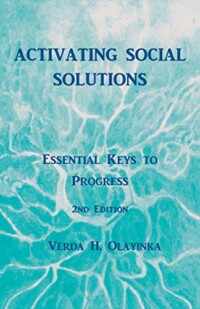Title: Activating Social Solutions: Essential Keys to Progress
Author: Verda H. Olayinka
Publisher: Balboa Press; 2nd Edition
ISBN: 1982258446
Pages: 218
Genre: Social Studies
Reviewed By: Dan MacIntosh
Pacific Book Review
 Author Verda H. Olayinka has a lot on her mind with her book Activating Social Solutions: Essential Keys to Progress. Her overall topic is nothing short of the hoped-for-salvation of a people. The American black community, whom Olayinka prefers to call Kemetic people, have had, and continue to have, big challenges. It is Olayinka’s intention to explore as many of these as can be fit into a 218 page book. With this, the second edition of her book, Olayinka goes into great detail with her wide-ranging studies and commentary.
Author Verda H. Olayinka has a lot on her mind with her book Activating Social Solutions: Essential Keys to Progress. Her overall topic is nothing short of the hoped-for-salvation of a people. The American black community, whom Olayinka prefers to call Kemetic people, have had, and continue to have, big challenges. It is Olayinka’s intention to explore as many of these as can be fit into a 218 page book. With this, the second edition of her book, Olayinka goes into great detail with her wide-ranging studies and commentary.
For starters, Olayinka intends to “set the record straight, clearing beliefs that African Americans, genetic descendants of Ancient Kemet, lack history until the event of slavery.” To that end, Olayinka spends a good amount of space early on describing some of the many accomplishments of black people throughout history.
With the book’s second chapter, “Calling a Spade, a Spade – No Apologies,” Olayinka takes on big issues, such as instances of troubling police enforcement. Such a section would not be complete without discussion of the relatively recent George Floyd killing, which set off multiple protests and heled fuel the Black Lives Matter movement. Olayinka’s research helps gives this incident – and incidents like it – much needed and necessary context.
The project’s next chapter is called “Saggin’: Beyond Blaming the Victim”. Many, including a lot of folks within the Kemet community, strongly dislike the sight of young men wearing sagging pants. However, Olayinka gets beyond the bad imaging of such fashion choices and digs deeper into why young men dress this way. She even brings out some of the possibly unconsidered health risks in wearing pants this way.
“Melanin Revisited,” the fourth chapter, finds Olayinka discussing that dark brown to black pigment occurring in the hair, skin and iris of the eye. This chapter goes into such great depths, it sometimes almost reads like a medical journal. Olayinka also writes about Kemet disenfranchisement in this heady, multiple-subject chapter.
A chapter about “Ethnic Manipulation: A Case Study of Jamaica, Queens, NYC” is, perhaps, this book’s most practical section. In it, Olayinka writes specifically about city planning for Jamaica, Queens, but she could just as easily be referring to almost any major metropolis. Yes, we all get shocked – or should get shocked – whenever we hear someone use the derogatory “N” word, but racist behavior is likely even more dangerous when it is done in a structural way, as with how city planning departments sometimes do their work. Within this same chapter, Olayinka also considers drug abuse and health issues, which are many times Kemet-associated. One health crisis especially fresh in our minds is the recent Covid-19 pandemic, which hit people of color particularly hard. Olayinka is careful to make sure facts about Covid-19 and the black community are made explicitly known.
For “Life in Our Father’s House,” chapter six, Olayinka gets personal, writing about her father, Warren L. Harris, whom she describes as “an artist, a musician, and a high school educator.” Olayinka is also an educator, likely because her father set such a great example. She grew up in a good family “personified by love and discipline in a mutually supportive social and religious community.” Granted, not everyone is blessed with such a fine family. However, his story (and her story, too) is a testament to the power of a strong family unit.
With a chapter called “We Have Done This Before – We Can Do it Again,” Olayinka provides a bit of a pep talk. Throughout this book, Olayinka sprinkles in her observations of various movements within the Kemet community. She has seen the good, the bad and the ugly, yes, but she remains hopeful and positive. She believes the Kemet community can come together and make positive changes. It is why she called her book “Activating Social Solutions.”
Quite naturally, then, this book’s last chapter is simply titled “Activating Solutions.” This work isn’t just history, for history’s sake. It is history – much of the time – presented for a greater purpose. There is much to learn from Olayinka’s labors, which – hopefully – will lead to those types of positive changes she longs to see in her lifetime.


